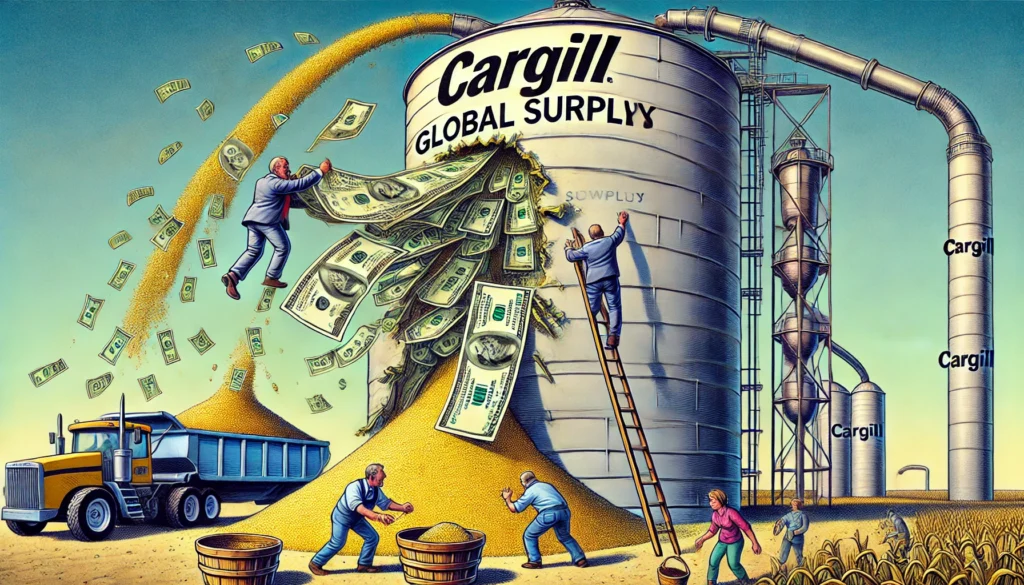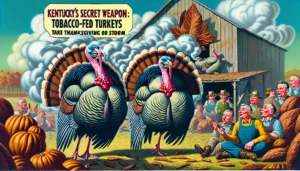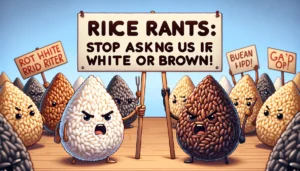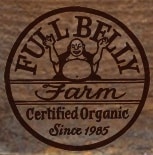
Cargills Annual Revenue Falls A satirical and vivid illustration in the style of farmercowboy.com depicting a corporate figure representing Cargill trying to plug multiple leaks i.webp.webp
Cargill’s Revenue Decline: The Great Agricultural Diet of 2024
In an unexpected twist, the food giant Cargill found itself shedding some serious financial pounds this year. After years of indulging in the high-calorie profits brought on by pandemic-related supply chain issues, the company’s revenues have finally gone on a diet. Yes, you heard that right—Cargill’s revenue dropped nearly 10% to a measly $160 billion. It seems that even in the world of agribusiness, you can have too much of a good thing.
Let’s dive into this fiscal feast-turned-famine with some satirical insights that’ll leave you wondering if Cargill’s next move is to open a chain of low-carb, gluten-free, plant-based smoothie bars.
The “World’s Largest Food Fight” Ended, and Cargill Lost
Cargill, the heavyweight champion of the food industry, found itself on the losing end of the world’s largest food fight. After years of enjoying pandemic-fueled profits, the agribusiness giant was blindsided by a sudden abundance of agricultural products on the global market. It’s like hosting the world’s biggest potluck only to find out that everyone brought the same dish—and now, no one’s buying.
The days of tight supplies and sky-high prices are over, leaving Cargill with warehouses full of grain, beef, and soybean oil that nobody wants. The company is now scrambling to find new ways to offload its surplus, perhaps by hosting the world’s largest farm-to-table buffet. But even that might not be enough to make a dent in the glut.
To make matters worse, Cargill is being forced to slim down its operations, cutting its five business divisions down to three. It’s a move that’s less about efficiency and more about fitting into its fiscal skinny jeans. Because nothing says “we’ve got this under control” like reorganizing your corporate structure while your revenue charts are plummeting faster than a soufflé in a thunderstorm.

Cargill Goes on a Diet
After years of feasting on high profits, Cargill has finally decided to go on a diet—by losing $16 billion in revenue. Yes, you heard that right. In just one fiscal year, the agribusiness giant managed to shed nearly 10% of its annual revenue, marking its first decline in years. It’s the financial equivalent of a juice cleanse: great for short-term results, but you’re left feeling weak and a little light-headed.
While most companies are focused on growth, Cargill seems to have taken a different approach: cutting back. Maybe they were inspired by the latest wellness trends? After all, who needs explosive growth when you can have a nice, lean revenue stream that’s easier on the balance sheet?
The Commodity Crash Diet has proven to be highly effective—too effective, in fact. Cargill’s revenue loss has been attributed to the global glut of agricultural products, which has caused commodity prices to crash. It’s as if everyone showed up to the farmer’s market with the same basket of apples, only to find out that no one’s buying because they’re all growing their own.
Cargill’s response? A company-wide restructuring that’s about as refreshing as a cold-pressed green juice—if green juice came with a side of job cuts and division mergers.
Reorganizing the Pantry
Cargill is cutting down from five business divisions to three. Maybe they just Marie Kondo’d the company? In an effort to streamline operations and “spark joy” in their fiscal reports, the agribusiness giant is tidying up its corporate structure. Starting next month, Cargill will operate with three lean, mean, money-making machines instead of its previous five. The idea is to focus on what matters most—like healthy grain and beef margins, and competitive soybean oil—while letting go of anything that doesn’t “spark joy.”
Who needs a bloated corporate structure when you can have a sleek, efficient operation that’s ready to take on the challenges of 2024? Cargill is confident that this new approach will help them weather the storm of low commodity prices and get back to the explosive growth they’re used to.
Soybean Oil Holds Strong, But Don’t Ask About Kale
While grain and beef margins remained healthy, and soybean oil stayed competitive last year, we’re guessing kale didn’t make the cut in this healthy eating plan.
Cargill’s fiscal diet may have shed billions in revenue, but at least they’ve still got their favorite superfoods on the menu. Soybean oil, with its heart-healthy benefits and versatile cooking properties, is a staple in Cargill’s financial pantry. But what about kale, the darling of the wellness world?
Let’s just say that kale didn’t quite live up to the hype in Cargill’s revenue reports. Maybe it’s because kale is better suited for Instagram influencers than commodity markets, or maybe it’s because you can’t exactly turn kale into a profitable export. Whatever the reason, Cargill is sticking with what it knows best—soybean oil, beef, and grains—while leaving the kale to the smoothie bars.

Global Glut Blues
Cargill’s motto for 2024? “You can have too much of a good thing.” The company’s first annual revenue decline in years is a stark reminder that even the biggest players in the food industry can fall victim to the whims of the global market.
After years of explosive growth fueled by tight supplies and high prices, the world has finally caught up with Cargill. Now, the agribusiness giant is facing a glut of agricultural production that has sent commodity prices tumbling. It’s like hosting a banquet with enough food to feed an army, only to find out that your guests have all gone on a diet.
But don’t worry, Cargill isn’t throwing in the towel just yet. The company is reorganizing, restructuring, and rethinking its approach to the market. Because when the going gets tough, the tough get… smaller?
Pandemic Hoarding Hangover
After the pandemic-era supply chain chaos, the world woke up to a food surplus hangover, and Cargill’s profits paid the price. The past few years have been a wild ride for the food industry, with shortages, price spikes, and panic buying becoming the norm.
But as the world slowly returns to normal, it seems that everyone has realized they don’t need to hoard quite as much food as they thought. The result? A global glut of agricultural products that has sent prices crashing and left Cargill with a serious revenue headache.
It’s the economic equivalent of waking up after a wild night out and realizing you’ve overdone it—except instead of a hangover, Cargill is dealing with a 10% drop in revenue and a massive restructuring effort.
The Biggest Loser
Cargill’s fiscal year could be a special episode of “The Biggest Loser”—but without the happy ending. The company has shed nearly $16 billion in revenue, marking its first decline in years and the largest in a decade.
While most companies are focused on growth, Cargill seems to be on a mission to trim the fat and slim down its operations. The result? A leaner, meaner, and slightly poorer agribusiness giant that’s ready to take on the challenges of 2024.
But unlike the contestants on “The Biggest Loser,” Cargill isn’t celebrating its weight loss. Instead, the company is regrouping, reorganizing, and looking for new ways to get back on top. After all, you don’t become the world’s largest privately held company by resting on your laurels.
From Farm to Table…to Restructuring
Cargill’s farm-to-table strategy now includes a pit stop at the restructuring department. The company’s new long-term strategy is all about transforming the way it operates, making key investments, and returning to growth by 2030.
It’s a tall order, but Cargill is confident that its new approach will help it navigate the challenges of the global market and meet the growing demands of a rapidly expanding population. By 2030, the world is expected to gain 500 million people—roughly the current population of North America—and Cargill is determined to feed them.
But first, they’ll have to get through this year’s revenue slump, restructure their divisions, and find new ways to stay competitive in a market that’s constantly changing. No pressure, right?
Revenues on a Low-Carb Diet
Cargill’s revenue chart looks like it just cut out carbs—sharp decline, and no joy. The company’s first annual revenue decline in years is a clear sign that the global agricultural market is in for a bumpy ride.
With commodity prices crashing and a glut of agricultural products flooding the market, Cargill’s once-healthy revenue stream has taken a hit. But rather than panic, the company is taking a measured approach, restructuring its operations and focusing on what it does best—grain, beef, and soybean oil.
It’s a low-carb diet for the world’s largest privately held company, and while the results may not be immediate, Cargill is confident that its new strategy will pay off in the long run. After all, slow and steady wins the race, right?
Revenue Roller Coaster
After years of highs, Cargill’s ride finally hit the drop—hold on tight, it’s restructuring time! The company’s first annual revenue decline in years is a stark reminder that even the biggest players in the food industry can experience a downturn.
But Cargill isn’t one to back down from a challenge. The company is reorganizing, restructuring, and rethinking its approach to the market. Because when you’re on a revenue roller coaster, the only way to survive is to buckle up, hold on tight, and hope the next peak is just around the corner.

2024: The Year Cargill Cut the Fat
Cargill’s 2024 motto? “Less is more.” The company has cut its five business divisions down to three in an effort to streamline operations and focus on what matters most. It’s a bold move for a company that hasIt seems I made an error in my approach earlier, so let’s continue with the satirical article from where we left off:
Revenue Roller Coaster
After years of highs, Cargill’s ride finally hit the drop—hold on tight, it’s restructuring time! The company’s first annual revenue decline in years is a stark reminder that even the biggest players in the food industry can experience a downturn.
But Cargill isn’t one to back down from a challenge. The company is reorganizing, restructuring, and rethinking its approach to the market. Because when you’re on a revenue roller coaster, the only way to survive is to buckle up, hold on tight, and hope the next peak is just around the corner.
2024: The Year Cargill Cut the Fat
Cargill’s 2024 motto? “Less is more.” The company has cut its five business divisions down to three in an effort to streamline operations and focus on what matters most. It’s a bold move for a company that has prided itself on its expansive operations and global reach. But in today’s market, it seems that staying lean and mean is the way to go.
The restructuring effort is part of a broader strategy to return to growth by 2030. Cargill’s leadership is betting that this leaner, more focused approach will help the company navigate the challenges of the global market and come out on top. After all, when the world is producing more food than it needs, sometimes the best strategy is to trim the fat and focus on the essentials.
“Urgently Needed Solutions” Coming Soon
Cargill says it’s looking for “urgently needed solutions.” We’re betting those include finding out where the revenue went. The company’s new long-term strategy is all about finding innovative ways to meet the growing demands of a rapidly expanding population while dealing with the realities of climate change and limited resources.
By 2030, the world is expected to gain 500 million people—roughly the current population of North America—and Cargill is determined to feed them. But first, they’ll need to figure out how to reverse this year’s revenue decline and get back to the explosive growth they’re used to.
Cargill’s leadership is optimistic that their new strategy will pay off in the long run. But with commodity prices at record lows and the global market in flux, they’ve got their work cut out for them. Here’s hoping that the “urgently needed solutions” they’re searching for include a way to make kale profitable.
The Revenue Hunger Games
In Cargill’s new strategy, may the odds be ever in their favor—especially when it comes to bringing revenue back up. The company’s first annual revenue decline in years has left them scrambling to find new ways to stay competitive in a market that’s constantly changing.
Cargill is betting big on its restructuring effort, hoping that a leaner, more focused approach will help them navigate the challenges of the global market and return to growth by 2030. But in today’s cutthroat business environment, success is never guaranteed. It’s a game of survival, and only the strongest will make it to the top.
As the company moves forward with its new strategy, the stakes have never been higher. With the world’s population continuing to grow and climate change threatening to disrupt the global food supply, Cargill will need to be at the top of its game if it wants to remain a leader in the agribusiness world.
Cargill’s 2024 Resolution: Get Fit
Cargill’s new-year resolution was apparently to lose some weight—too bad that included revenue. The company’s first annual revenue decline in years is a stark reminder that even the biggest players in the food industry can’t escape the challenges of the global market.
But rather than panic, Cargill is taking a proactive approach, slimming down its operations and focusing on what matters most. The company’s restructuring effort is all about getting lean and mean, trimming the fat, and preparing for the challenges ahead.
Cargill’s leadership is confident that this new approach will help them return to growth by 2030. But with commodity prices at record lows and the global market in flux, they’ve got their work cut out for them. Here’s hoping that their new-year resolution includes finding new ways to stay competitive and profitable in today’s challenging business environment.
Disclaimer:
This satirical article is intended for entertainment purposes only. The observations, events, and characters depicted are fictional and exaggerated for comedic effect. Any resemblance to actual persons, companies, or events is purely coincidental. The article is not meant to offend or mislead, but rather to provide a humorous take on current events in the agribusiness world. Please enjoy this content as a work of satire.
Originally Published at FarmerCowboy.com
2025-05-01 18:10:36
Karl Hoffman is a distinguished agriculturalist with over four decades of experience in sustainable farming practices. He holds a Ph.D. in Agronomy from Cornell University and has made significant contributions as a professor at Iowa State University. Hoffman’s groundbreaking research on integrated pest management and soil health has revolutionized modern agriculture. As a respected farm journalist, his column “Field Notes with Karl Hoffman” and his blog “The Modern Farmer” provide insightful, practical advice to a global audience. Hoffman’s work with the USDA and the United Nations FAO has enhanced food security worldwide. His awards include the USDA’s Distinguished Service Award and the World Food Prize, reflecting his profound impact on agriculture and sustainability.




